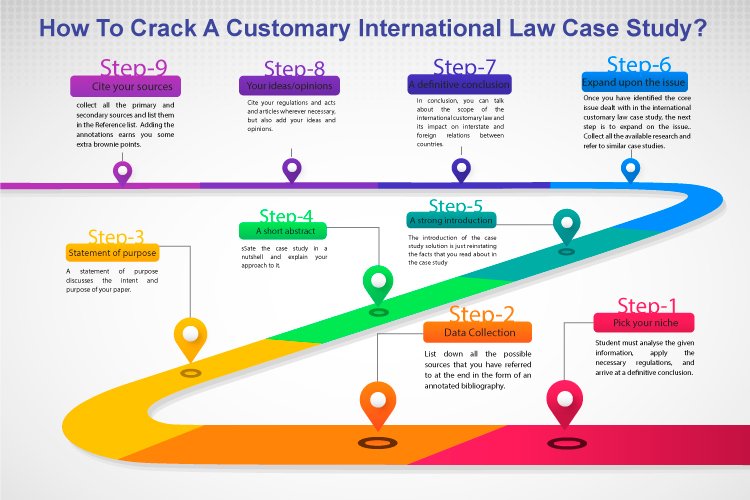Studying law is no child’s play. Your curriculum is full of complicated legal jargon, laws, articles, acts and amendments. However, there’s a special place in international law that is the stuff of nightmares! Students dread this subject because of its complex extensive curriculum and even tougher assignments.
International law tackles inter-continental relationships, diplomatic connections between nations to ensure global fair-trade practices. The customary law is but one part of this extensive field of study that deals with taxations, customs, import and exports between countries.
It is tough to crack a custom international law case study. You need an in-depth understanding of the trading practices, economics etc. of the countries. In a case study, students can explore the many aspects of the customary law and how it actually works in day-to-day life.
Here is a stepwise guide to cracking a customary international law case study all law students should read through. But first let us have a quick overview of the law and its importance.
All about International Customary Law
International custom is the second most significant source of international law, as stated by Article 38 of the International Court of Justice. For the uninitiated, International law basically deals with inter-state and inter-country relations. This includes the treaties and custom laws between states when it comes trade and commerce.
A custom international law case study would therefore be about the custom treaties and regulations surrounding financial practices, currency exchanges, import/exports of goods etc.
Step 1- Pick your niche
International law is an extensive field, and you cannot possibly cover every aspect of it in your case study. In fact, the case study only deals with a specific case or situation, real-life or otherwise. The student must analyse the given information, apply the necessary regulations, and arrive at a definitive conclusion.
I would recommend the student to read the case study multiple times to understand its contents. Note that only a few of the customary international laws that can rise to the level of jus cogens when voted by enough states. While other customary laws don’t require a majority vote in order to be implemented.
Jus cogen is a section that refers to certain human rights that are fundamental, irrespective of the country’s social, political or economic beliefs.
Also, note that jus cogens and customary laws are not interchangeable. All jus cogens cases might be customary international laws, but not all customary international law cases rise to the level of jus cogens.
Jus cogens are non-derogable. A state can deviate from a customary international law regulation by enacting conflicting treaties between two countries. These are but some of the intricacies that you must understand before you pick a niche.
Step 2- Data Collection
Once you have an idea about the case study and the jurisdiction it falls under, the next step is research. In a case study, the student usually has to be limited to the data provided in the passage. However, you can refer to similar case studies and instances and use them as a hypothesis to substantiate your argument here.
Read up on the existing laws and regulations that can be applied to the case. Ensure that these regulations are in lieu of the IJC. The International Court of Justice or IJC is a body that monitors and regulates inter-state relations between countries. This body is responsible for resolving global disputes, judging acts against humanity, penalizing nations that go against the basic human rights of the citizens etc.
Adding stats, numbers and infographics to your case study solution also makes your argument and hypothesis more credible. In law, everything must be backed by evidence and you cannot claim things unless they are explicitly stated or mentioned in the law.
Also, list down all the possible sources that you have referred to at the end in the form of an annotated bibliography. But more on that later.
Step 3- Statement of purpose
The statement of purpose and the research proposal usually comes as the first thing in any law case study paper. This applies to all sectors of law, from solving business law case studies, to cracking civil law cases or criminal law instances- you need a research statement everywhere.
In customary international law, you get multiple instances of financial fraud, human rights violation, or some other form of international breach. A statement of purpose discusses the intent and purpose of your paper. In this case, you will analyse the main problem statement of the case study and your approach to solve it.
Step 4- A short abstract
The abstract comes next where you can talk a little bit about the primary and secondary sources referred to in the paper. The abstract is a short passage that is about 250-300 words long. Here you can also state the case study in a nutshell and explain your approach to it.
I recommend students to add a list of relevant keywords used in the paper as well towards the very end. This gives the reader a fair idea of what to expect from the case study solution.
Step 5- A strong introduction
The introduction of the case study solution is just reinstating the facts that you read about in the case study. An international customary case study can be about pretty much anything from economics, human rights, trade relations, war, peace treaties etc.
And customary international law is usually about the relationships between states and their behaviours with each other. It binds nations together, and has only two elements that you must keep in mind:
- The state practices are uniform and consistent over a period of time
- States behaving on the assumption that these practices are obligatory
Step 6- Expand upon the issue
Once you have identified the core issue dealt with in the international customary law case study, the next step is to expand on the issue. In the opening para, you list down the facts, collect all the available research and refer to similar case studies.
Now, every case study has a few objective questions, and a lot of open-ended questions. You can easily answer the definitive or objective ones. It is the open-ended questions that require some thought. It also gives you the space to explore the different facets of international customary law and explain your understanding of it.
You need to state your hypothesis before you begin to defend or disprove the argument. To address these sections, you need to first refer to the existing research done in the field. Read up on similar case studies on international customary law. Also use those insights to justify your argument.

Step 7- A definitive conclusion
Keep the tone and structure of the case study solution chronological, this means that the ending para would be about reinstating your points. This comes after you have stated the facts, discussed your points and given appropriate answers to the questions asked in the case study.
In conclusion, you can talk about the scope of the international customary law and its impact on interstate and foreign relations between countries.
Step 8- Your ideas/opinions
The professor ultimately wants to see how much you’ve understood of the topic. So, don’t just state the facts, try to explain them in your own terms. Use simple, stylish academic language for the same. I understand that you cannot change the wording a lot in a law paper. Cite your regulations and acts and articles wherever necessary, but also add your ideas and opinions.
Step 9- Cite your sources
Finally, you need to collect all the primary and secondary sources and list them in the Reference list. For law case studies, I would suggest you use the APA or Griffith in-text referencing styles as they are accurate for fact-based papers.
You should also add an annotated bibliography at the end of your case study solution. Adding the annotations earns you some extra brownie points.
Quick links and references
Elements of customary international law
Formation and Evidence of Customary International Law
The necessary distinction between jus cogens and customary international law
Get help from professional law experts
Law is a tough nut to crack, and international customary law more so because of its universal appeal and applicability. Reach out to Assignment Essay Help today and get all the help you need from our law experts and professionals!

 WhatsApp Us
WhatsApp Us